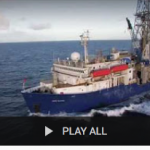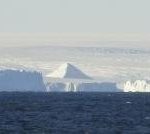
Wilkes Land Glacial History
The Wilkes Land Glacial history expedition started in Wellington, New Zealand on 4 Jan 2010 and returned to Hobart, Tasmania on 9 March. While off the coast of Antarctica, we took cores from the seafloor to investigate when and why the ice sheet started growing on Antarctica and how the ice sheet has grown and melted during the last 35 million years.
We focused on learning about the interaction of climate, ice sheet growth, and ocean currents. The sediment cores we brought into the labs on the ship covered periods in Earth’s history that were extremely warm – think palm trees and crocodiles at the poles – instead of polar bears and penguins!
At one of the expedition sites, we obtained a super-high resolution record (very detailed) of just the last 10,000 years – the sediment at this site was deposited so quickly that each yearly layer is about 3 cm thick. This gives us an Antarctic climate history record just like what tree rings can give.
Why did we do this? If we want to have any chance of predicting how our climate might change in the future, we must understand how the Earth’s climate system (air, ice, oceans) worked in the past. The sediments deposited on the seafloor record the climatic and oceanographic conditions at the time they were deposited – our sediment cores are one of the only and best ways we can get at this important information.
Follow along with these great resources!
- JR Blogs – Many scientists record their adventures and write about their lives and work at sea on the JR Blog Page.
- Museum, magazine, and univeristy blogs – Expedition 318 particpants shared their impressions on a number of interesting and well-known sites in addition to the JR blogs.
- Sandra Passchier’s blog is on the Montclair State University site.
- Read what Tina van de Flierdt has to say in her blog on the Imperial College London website.
- If you can read Dutch, try the blogs by co-chief Henk Brinkhuis and palynologist Peter Bilj.
- You can also watch an interview with Peter on Dutch TV!
- Can you read Italian? if so, you can read our blogs on the Italian Antarctic Museum’s website. in other words…Parli italiano? allora puoi seguire il nostro blog sul sito del Museo Nazionale dell’Antartide
- Rob Dunbar posted dispatches and video to the Exploratorium’s award-winning Ice Stories website, where they have a special project page just for Wilkes.
- For the science savvy, a detailed scientific prospectus can be downloaded from the IODP-USIO webpage.
- Weekly video updates: Our friends at Zcene Moving Media produced lots of exciting “moving pictures.” You can find all of them here.



Good day!
My name is aby and my father is working in your ship…im not sure if you know him…
i always visit ur site and check for some of your updates and where abouts…. i found it so amazing and interesting =)
im always praying that you’ll always have a safe expidition,may god bless u all as well as your trip….
oh i almost forgot im filipino and my dad’s name is silverio mayuga(but they call him jerry(from batangas city) he left MNL last 08MAR2010 i heard u guys heading to australia, and i feel sad coz im here in dubai so i didnt got a chance to hug him before he left …miss my family so bad anyway, till then hope somebody will find time to read my message…
again godbless u all and your always on my prayer!!!
The Wilkes Land Glacial history expedition to Antarctica which started in Wellington, New Zealand on 4 Jan 2010 gave me some ideas for writing my research project on Antarctica exploration. Thanks for amazing ideas!
Alex
I can’t agree more with you saying that if we want to have any chance of predicting how our climate might change in the future, we must understand how the Earth’s climate system (air, ice, oceans) worked in the past. Nowadays everything changes so quickly so we must really hurry to be ready to accept the changes. It is so nice that there are people who is eager to dedicate so much time and countless efforts to this project, ready even to risk their lives for the sake of science. It is unbelievable to find out that about 55Ma Antarctica which each of us usually saw on TV or in the movies as a piece of land covered with ice, was a warm sub tropical paradise with carbon dioxide levels eleven times todays value!!! Suddenly within a relatively short geological time frame of 0.5Ma it reverted to a freezing ice covered cold expanse with ice sheets, what we see today. I’ve always been interested in the amazing processes taking place in the nature of our planet and I highly admire your work. The value of it can hardly be overestimated.